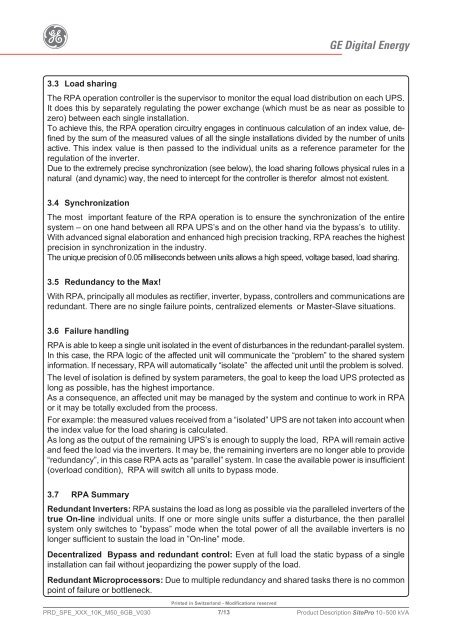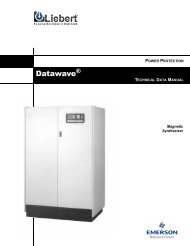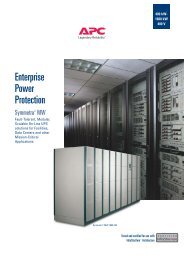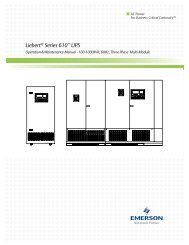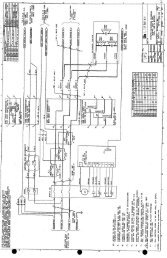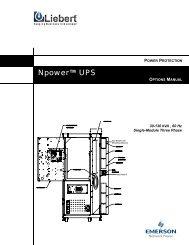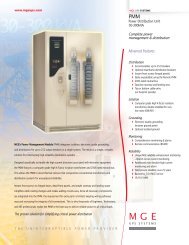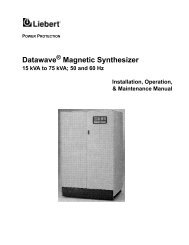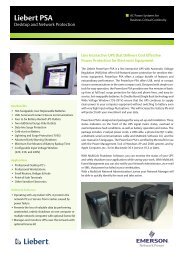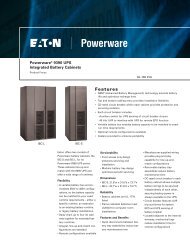GE SitePro Brochure.pdf - Gruber Power
GE SitePro Brochure.pdf - Gruber Power
GE SitePro Brochure.pdf - Gruber Power
Create successful ePaper yourself
Turn your PDF publications into a flip-book with our unique Google optimized e-Paper software.
g<br />
<strong>GE</strong> Digital Energy<br />
3.3 Load sharing<br />
The RPA operation controller is the supervisor to monitor the equal load distribution on each UPS.<br />
It does this by separately regulating the power exchange (which must be as near as possible to<br />
zero) between each single installation.<br />
To achieve this, the RPA operation circuitry engages in continuous calculation of an index value, defined<br />
by the sum of the measured values of all the single installations divided by the number of units<br />
active. This index value is then passed to the individual units as a reference parameter for the<br />
regulation of the inverter.<br />
Due to the extremely precise synchronization (see below), the load sharing follows physical rules in a<br />
natural (and dynamic) way, the need to intercept for the controller is therefor almost not existent.<br />
3.4 Synchronization<br />
The most important feature of the RPA operation is to ensure the synchronization of the entire<br />
system – on one hand between all RPA UPS’s and on the other hand via the bypass’s to utility.<br />
With advanced signal elaboration and enhanced high precision tracking, RPA reaches the highest<br />
precision in synchronization in the industry.<br />
The unique precision of 0.05 milliseconds between units allows a high speed, voltage based, load sharing.<br />
3.5 Redundancy to the Max!<br />
With RPA, principally all modules as rectifier, inverter, bypass, controllers and communications are<br />
redundant. There are no single failure points, centralized elements or Master-Slave situations.<br />
3.6 Failure handling<br />
RPA is able to keep a single unit isolated in the event of disturbances in the redundant-parallel system.<br />
In this case, the RPA logic of the affected unit will communicate the “problem” to the shared system<br />
information. If necessary, RPA will automatically “isolate” the affected unit until the problem is solved.<br />
The level of isolation is defined by system parameters, the goal to keep the load UPS protected as<br />
long as possible, has the highest importance.<br />
As a consequence, an affected unit may be managed by the system and continue to work in RPA<br />
or it may be totally excluded from the process.<br />
For example: the measured values received from a “isolated” UPS are not taken into account when<br />
the index value for the load sharing is calculated.<br />
As long as the output of the remaining UPS’s is enough to supply the load, RPA will remain active<br />
and feed the load via the inverters. It may be, the remaining inverters are no longer able to provide<br />
“redundancy”, in this case RPA acts as “parallel” system. In case the available power is insufficient<br />
(overload condition), RPA will switch all units to bypass mode.<br />
TEMPORARY<br />
3.7 RPA Summary<br />
Redundant Inverters: RPA sustains the load as long as possible via the paralleled inverters of the<br />
true On-line individual units. If one or more single units suffer a disturbance, the then parallel<br />
system only switches to ”bypass” mode when the total power of all the available inverters is no<br />
longer sufficient to sustain the load in ”On-line” mode.<br />
Decentralized Bypass and redundant control: Even at full load the static bypass of a single<br />
installation can fail without jeopardizing the power supply of the load.<br />
Redundant Microprocessors: Due to multiple redundancy and shared tasks there is no common<br />
point of failure or bottleneck.<br />
PRD_SPE_XXX_10K_M50_6GB_V030<br />
Printed in Switzerland - Modifications reserved<br />
7/13<br />
Product Description <strong>SitePro</strong> 10-500 kVA


